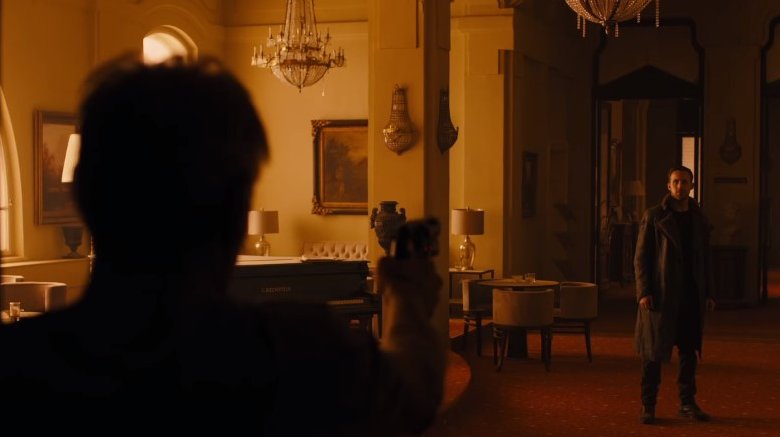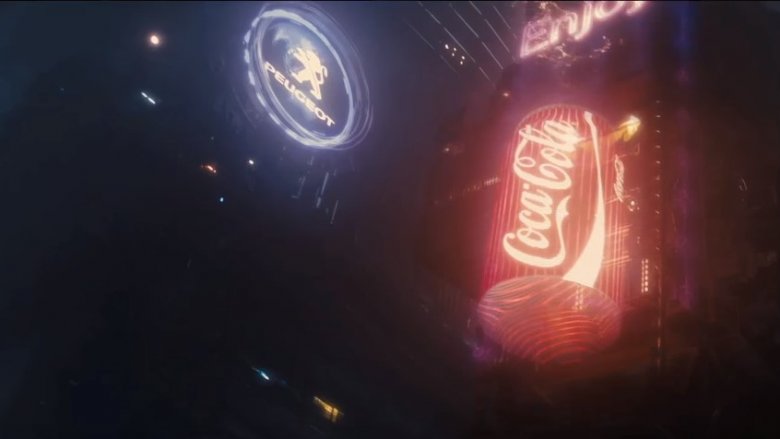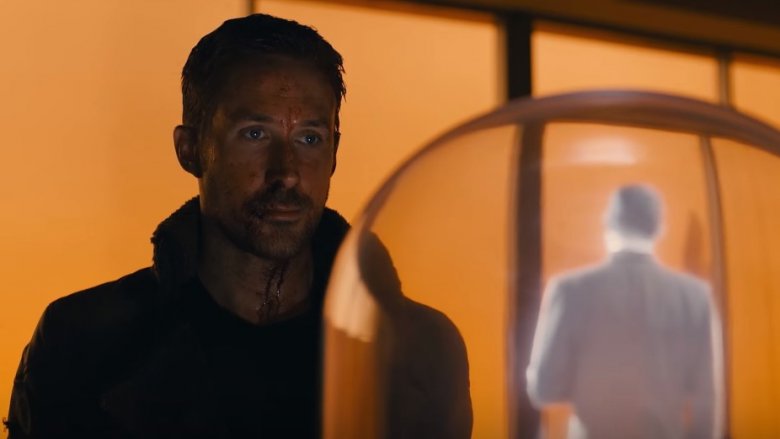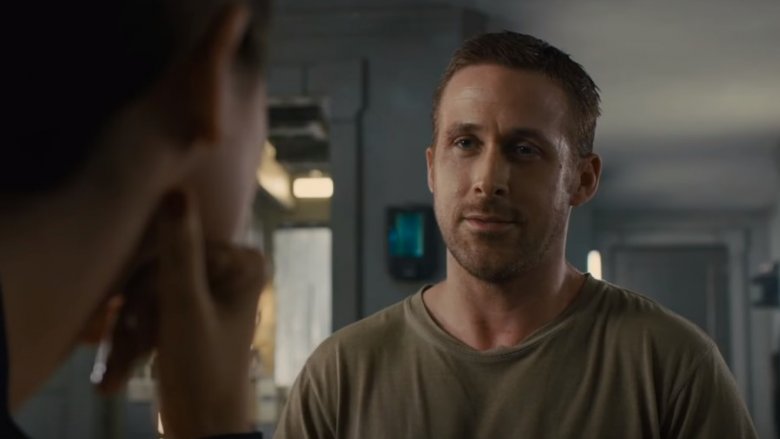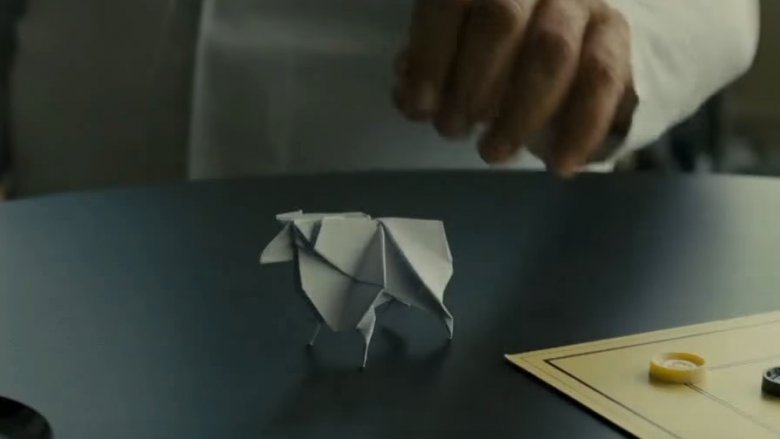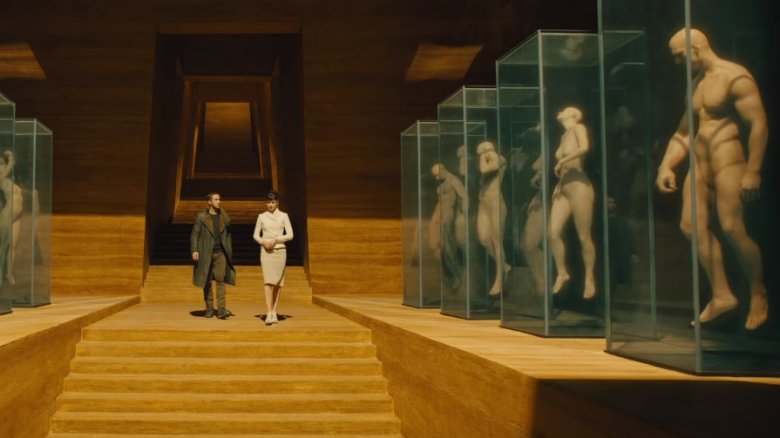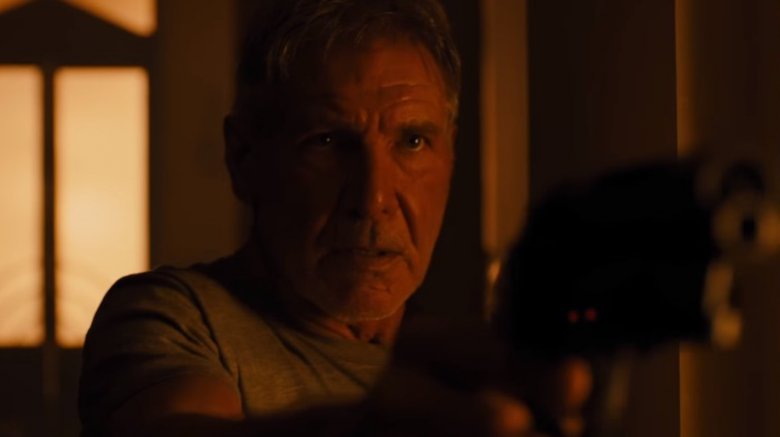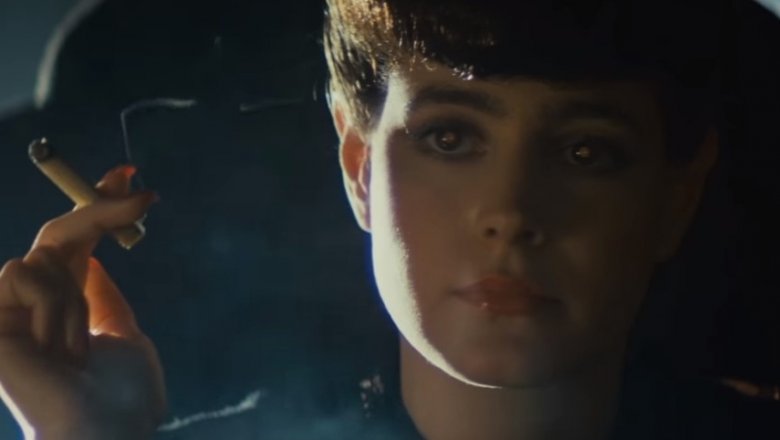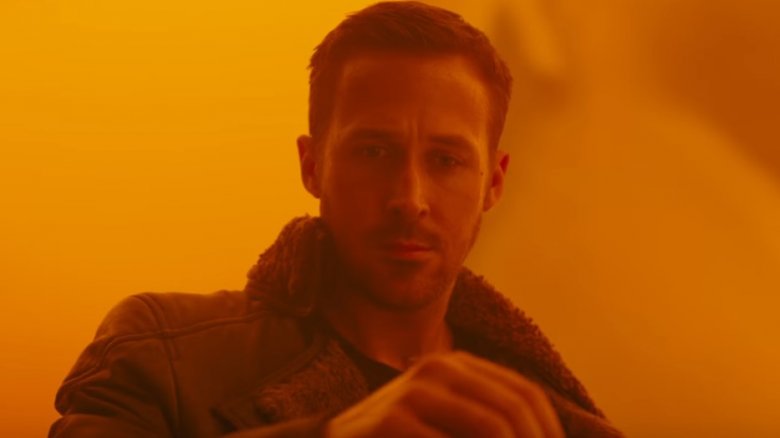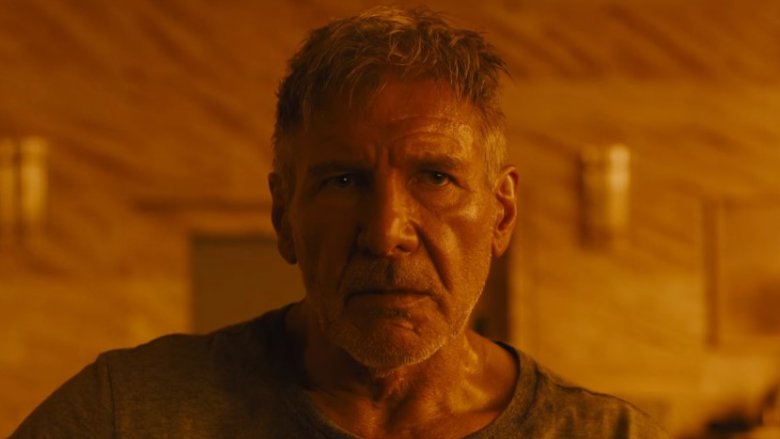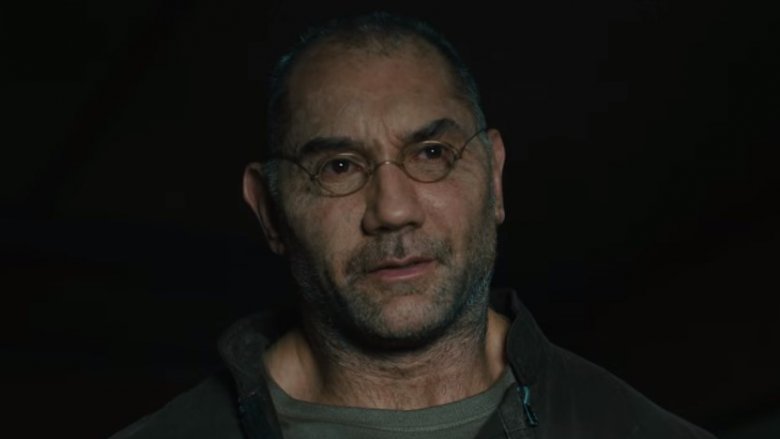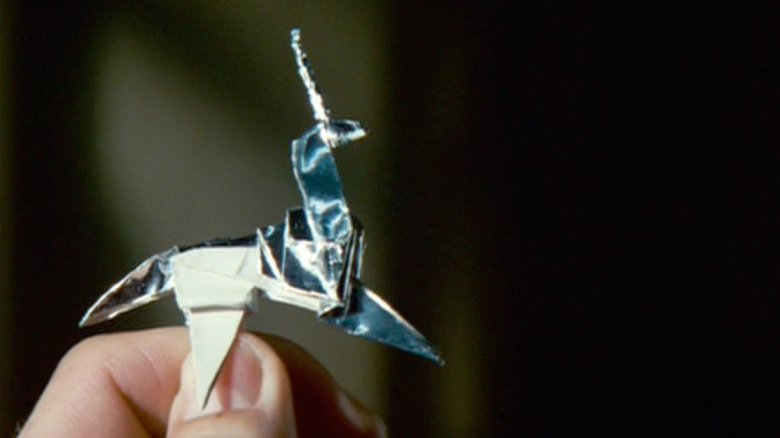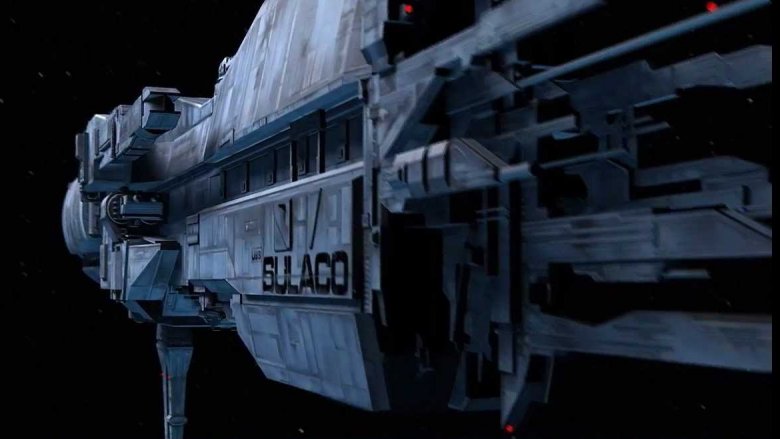Easter Eggs You Missed In Blade Runner 2049
Fans had to wait more than 30 years, but the sequel to 1982's Blade Runner is finally here, and it's stunning. Directed by Denis Villeneuve, Blade Runner 2049 pulls all the sleek visuals from the original and wraps them around a new storyline set 30 years after the original, following a new blade runner, Officer K (Ryan Gosling), tasked with rounding up the remaining early-generation replicants.
But it's harder to hunt replicants than it is to hunt Easter eggs, so we took the easy job and found everything you missed in Blade Runner 2049. Spoilers ahead!
Vintage inspiration
Blade Runner 2049's art direction is phenomenal from start to finish. The L.A. sky is a bleak, rainy gray that hangs over the urban sprawl like a disapproving grandpa, San Diego's trash mountains rise like Olympus under a trailer-park Zeus, and Las Vegas' red Martian smog is perfectly tinged to hammer home the apocalyptic ruin of that once-great oasis in the desert. And that's just the outside.
Inside the casino where Deckard (Harrison Ford) lives, the set design perfectly conveys the dead-future version of all the different rooms and entertainment halls of a palatial Vegas attraction. But it didn't all come from thin air. In the piano room, where K first encounters Deckard, is a grand piano. In at least a few shots, you can even see the name on it: C. Bechstein. Cool, kind of. If you're into pianos. But as one Reddit user noticed, the imagery almost perfectly lines up with a 1920's era Bechstein poster. Everything from the coloring to the ornate chandelier hanging over the piano seems to be inspired by that image. If you noticed that, now's the time to go tell your dad that music history major did pay off. In a big way.
Enjoy Coca-Cola
The Los Angeles of the first Blade Runner is awash in the neon glow of corporate advertisement, ads playing hundreds of feet high on the sides of skyscrapers (how else would you corner that elusive flying car demographic?). But one of the most prominent ads in the first film is a display for Coca-Cola. Ridley Scott explained that the reason he used the Coke advertisement (along with Atari, Pan Am, and RCA, to name a few) was that "even in a dystopian world, Coca-Cola is everlasting."
Well, fast forward 30 even dystopian-er years, and apparently Coca-Cola really is everlasting. Even in a world where the only tree is dead and one guy's farming grubs to survive, Coca-Cola is still pumping out sky-high treatises to "Enjoy Coca-Cola." Considering the ad only made it into a few frames of this movie, we're calling that a definite nod to the original. By the same token, 2049 also had quick Atari and Pan Am advertisements, if you caught them. Unfortunately, Pan Am went defunct in 1991 and Atari was acquired by Hasbro in 1998, so they're definitely not around in 2049. At least they get to live on through the power of imagination! Right? Maybe?
Sony's hologram
Speaking of product placement, who would have a better reason to advertise their name than the international distributor of the whole shebang? When K finally tracks down Deckard in Las Vegas, he plugs a coin into a jukebox and brings a hologram of Frank Sinatra to life. And the name right there on the front of the machine? Sony. Of course. Hey, if Peugeot can make flying cars in this universe, why can't Sony make hologram machines?
Pale Fire
Every time K comes out of a stressful situation, he has to perform a "Post-Trauma Baseline Test." Presumably, this is something every replicant (or at least every replicant/blade runner) has to endure to make sure he's still operating at prime robotic capacity without any of those pesky human emotions sneaking into his hard drive. The baseline test is a mashup of poetry and cacophony, with K repeating words like "cell" and "interlinked" in response to various prompts.
It all seems like nonsense, but the movie left a subtle Easter egg to help fans decode just what the heck was going on there—sort of. As it turns out, all those lines were pulled from Vladimir Nabakov's novel Pale Fire. Specifically, this refrain: "Cells interlinked within cells interlinked/Within one stem. And dreadfully distinct/Against the dark, a tall white fountain played."
As for what that all means, it's still anyone's guess, but Nabakov's Pale Fire also happened to be the book Joi picked up in K's apartment. Either the script department left their copy lying around, or K's been boning up on what the Wallace Corp. has been filling his head with all these years.
Original origami
Qualifying as both an excuse to bring back a beloved character and an excuse for Edward James Olmos to grab a quick extra paycheck, Gaff made a quick appearance in Blade Runner 2049 when K was trying to track down information about Deckard. You may remember Gaff as the pointy-mustached blade runner who's always showing up to ruin Deckard's day in the first Blade Runner. With all of 20 seconds of screen time, his cameo in 2049 doesn't serve to advance the plot a whole lot, but it does offer up an opportunity for an on-the-nose Easter egg.
While K is asking Gaff about Deckard, the old man's hands are working busily out of sight behind the table. Just before K leaves, Gaff lays one of his signature origami figurines on the table. Which begs the question: If there aren't any trees left, where the hell is Gaff getting all this paper?
WAS that an engineer?
In 2012, fans scouring the Prometheus DVD came across a telling Easter egg—a letter dictated by Peter Weyland (Guy Pearce) of the Alien universe that supposedly references Eldon Tyrell (Joe Turkel) of the Blade Runner universe. In Prometheus, Weyland owns the company that produces androids; in Blade Runner, Tyrell owns the company that produces replicants. The letter never mentions Tyrell by name, but in it, Weyland calls the man in question his "mentor" and says that he's "like a God on top of a pyramid overlooking a city of angels." It goes on to say that this guy's robotics project "literally blew up in the old man's face."
Of course, in Blade Runner, the Tyrell Corporation was housed in a pyramid-shaped building in Los Angeles (a "city of angels") and Tyrell's rogue replicant, Roy Batty (Rutger Hauer), crushed his skull. So while Weyland may need to tone down his use of the word "literally," the references are all there.
Then, back in May 2017, fans watching the first trailer for Blade Runner 2049 noticed a figure that looks a lot like an engineer from Prometheus, launching speculation that the Tyrell Corporation (sorry, the Wallace Corporation) designed the first run of engineers. Is it all true after all? Unfortunately, the movie gives no hint whatsoever, but considering the lengths Ridley Scott is apparently willing to go to connect these universes without ever confirming it, it's still reasonable to consider this theory open to discussion.
Master Blaster
Between the more obvious holdovers from the first movie, like the spinners and Tyrell's tower, eagle-eyed fans may have noticed one particular artifact that made the leap from the original film—Deckard's blaster pistol. And the new version wasn't just close to its lethal ancestor; it was an exact replica of the actual prop used by Harrison Ford in Blade Runner.
Surprisingly, it isn't locked in a Hollywood warehouse somewhere—it was bought by a private collector, who was gracious enough to lend it to the filmmakers. According to Vice's Inside the Making of Blade Runner 2049, the prop team took the original gun and "recreated the blaster again bolt by bolt."
Nexus-7
To put the replicant timelines into quick perspective, in the original film, Harrison Ford's Deckard was hunting Nexus-6 models. In 2049, Dave Bautista's character is a Nexus-8, and Ryan Gosling's K is a Nexus-9. And, obviously, the androids evolve with each new model number. Nexus 6s had a four-year lifespan. Nexus-8s, like Bautista's Sapper Morton, can live much longer, and can apparently visibly age.
K's model, the Nexus-9s, are similar to the 8s, but are apparently much, much more subservient. In the "2036: Nexus Dawn" short, Jared Leto's Niander Wallace introduces the first Nexus-9, who's happy enough to stick a glass shard in his own jugular at a word from Wallace. They're pretty foolproof, is what we're saying.
So what about the missing model? Where are the Nexus-7s? As far as we know, neither film explicitly mentions a Nexus-7, but 2049 left an Easter egg that reveals Rachael (Sean Young) from the original film to be one of those—possibly the only—elusive Nexus-7s. When K is hunting down the serial number from the bones he found buried under that tree, the serial number begins with N7. It's possible that's short for Nexus-7. The bones, of course, turned out to belong to Rachael, which would make her a Nexus-7 (if that's what the serial number implies, anyway).
And that alone opens up a whole new can of worms. Could all the Nexus-7s reproduce? Was Rachael the only Nexus-7, or a special version? And if Deckard's a replicant, is he a Nexus-7 as well? Yeah, have fun answering those.
A real goat
While K and Joi are out tracking down Deckard, they stop at a shop owned by a guy named Doc Badger to get K's toy horse analyzed. Badger realizes it's made of real wood and starts offering trades to get his hands on what's obviously a ridiculously rare commodity in the Blade Runner world. But K ain't parting with his horsey, even when Badger sweetens the deal with an offer of a "real horse or goat." Mighty tempting, you might say. Mighty tempting indeed.
Well, hold your sarcasm, because that line was actually a callback to the original novel on which Blade Runner was based, Do Androids Dream of Electric Sheep. In it, Deckard is always looking for animals. For example, one line reads:
"'Ever thought of selling your horse?' Rick asked. He wished to god he had a horse."
Later, Deckard drops his entire bounty of $3,000 as a down payment on a goat. Deckard obviously loves his animals, which is hinted at in Blade Runner 2049, when we see that his Vegas hideaway is filled with animal sculptures, not to mention a pet dog. And speaking of those animals...
Animal acronym
According to a Reddit user, there's more to those animals in Deckard's apartment than meets the eye. We kept our eyes peeled for background clues, but couldn't make head or tail of what the animals were supposed to signify. Well, if this theory is true, the animals are an elaborate acronym that spells out Rachael's name. Don't hold us to this, but supposedly, the carved animals are a rhinoceros, antelope, cat, horse, elephant, and lion.
Take the first letter of each animal, and you get R-A-C-H-E-L. Of course, that's still missing the second "A" in Rachael's name, but hey—maybe there was a secret aardvark hiding in that room somewhere.
Opening homage
Blade Runner is notorious for the number of different cuts it has, and even before Ridley Scott's endless tinkering, some scenes from the script got the chop. One came at the very beginning of the film, and went a little something like this. Let us know if this sounds familiar:
Deckard breaks into a replicant's house on a farm and waits in the kitchen for the replicant to come home. Eventually, the replicant comes home, sees Deckard, and walks over to the stove to stir a pot that's bubbling away. He asks Deckard if he wants some soup, and then Deckard kills him.
Yup, that's basically the opening scene to Blade Runner 2049, only with K waiting in Sapper Morton's kitchen. And while Deckard ripped off the replicant's jaw in the original scene, K digs out Sapper's eyeball. But they were both after the same thing: serial numbers. Scott must have loved that original opening, because he's been talking about putting it in the sequel for years now. Either way, it's a fantastic homage to the first film.
More than a horse
Blade Runner and unicorns go hand in hand, so no doubt plenty of fans were scanning 2049 for a nod to Deckard's unicorn-filled dreams of the original film. Unfortunately, Gaff origami'd a sheep and K's wooden pony was just a run-of-the-mill horse, albeit an absurdly valuable one. Or was it? If you look closely, there's a slightly lighter section on the horse's forehead, suggesting something was broken off at some point. A horn, perhaps? Are we stretching? Well, consider it this way:
K's memories of the horse came from Dr. Ana Stelline, who had the horse as a child. She's Deckard's daughter, who obviously has a thing for wooden animals, considering how many there are in his Vegas suite. So it stands to reason that Deckard gave Ana the horse and carved her birth date into it. Is it a stretch to think that the toy Deckard gave his only daughter might have been a unicorn? We don't think so.
Eyes on the sky
Another Reddit theory posits that there's an Aliens Easter egg hiding in the skies during Blade Runner 2049. In one of the scenes of K flying above the city in his spinner, several fans noticed an airborne craft that resembles the USS Sulaco from 1986's Aliens—the ship carrying Ripley and the crew of Marines. It's hard to tell for sure—just about every vehicle in future Los Angeles is big, gray, and blocky, and even if the design was inspired by the Sulaco, that probably doesn't mean anything as exciting as a crossover. After all, Aliens takes place in 2179, 130 years after this film.
However, there is a bit of backstory that makes this Easter egg a little more likely. The Sulaco in Aliens was designed by conceptual artist Syd Mead, a longtime powerhouse in Hollywood sci-fi visuals. Mead also worked on the design of the original Blade Runner, and while 2049 was in production, director Denis Villeneuve brought him in to work on one of the scenes in the new film. Could that mysterious ship fans saw be an homage to one of the pioneers of modern sci-fi? Now that's something worth thinking about.
